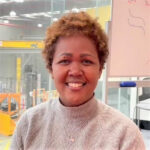8 March 2024
Mary Louise Madlangbayan

Despite long-standing perceptions, more and more women today are not only making strides but also reshaping the narrative of what it means to be a leader and innovator in the construction sector – paving the way for future generations of women in the field.
As the world celebrates International Women’s Day on the 8th of March, SmartCrete CRC, a for-impact Cooperative Research Centre (CRC) that invests in research and innovation to help transition concrete for a sustainable Australia, has reached out to four incredible women involved in its research collaborations who are passionate about advancing the concrete industry. Their stories show the transformative power of diversity and inclusion in an industry that is vital to global infrastructure and development.




It comes as no surprise that being a woman in the concrete industry presents its own unique set of challenges. According to Indira, what helped her overcome these would be having the right mindset and a supportive environment. “In navigating the traditionally male-dominated landscape of the concrete industry, I prioritised surrounding myself with individuals who champion equal opportunities, regardless of gender,” she emphasised.
Meanwhile, Olivia mentioned how having people skills can be advantageous in a highly technical industry like concrete. “You need to have interpersonal skills. You can have all the technical knowledge, but you need to be able to communicate that to people.”
For Sujeeva, the support of fellow researchers and mentors during the early stages of her career has contributed immensely to her success juggling both work and motherhood. “Despite taking two career breaks for maternity leave, I was able to sustain my credentials in the field thanks to the collaborations I established. These connections proved invaluable in maintaining my involvement and relevance within the research community.”
Josh echoed similar sentiments, acknowledging the importance of having a good relationship with colleagues. She noted, “what gets you through is support from colleagues and acknowledging that you can never do it all.”
Despite the hurdles, Josh believes that women are starting to take up space in the concrete industry. “I’ve never felt that the concrete industry was unwelcoming to women. In fact, women are highly valued and appreciated,” she shared. “Now, we see the emergence of women’s branches within technical organisations such as Engineers Australia women’s branch and CIA Women In Concrete, among others.”
However, Josh underscores the importance of industry encouraging more young girls to explore engineering and concrete-related careers. “It’s crucial for the industry to foster interest and awareness among young girls as early as possible, even before university,” she emphasised. “By providing opportunities for education and exposure to these fields, we can inspire the next generation of female professionals to contribute to the industry’s growth and innovation.”
When asked about the initiatives she hopes to see in the industry to further support and advance women professionals like herself, Olivia also resonated with the idea of having specific groups for women in the industry. “Having more groups or even events where you’re able to see women at a certain level – that’s inspiring. It makes you think that if she can do that, I can do that too,” she concluded, highlighting the importance of visibility and representation in inspiring future generations of women in the field.
Meanwhile, Indira highlighted the need for more financial support and mentoring opportunities tailored specifically for students like herself who are interested in studying and researching concrete. “By providing such resources, we can empower more women to enter and excel in the industry, fostering a more diverse and inclusive environment that benefits us all,” she mentioned.
In a similar note, Sujeeva believes that the invaluable contributions of women in the concrete industry are essential to tackling future challenges in achieving a net-zero future without sacrificing economic benefits. “It’s crucial to recognise that these efforts to promote female contribution to the concrete industry are not solely for the sake of equity but also for the substantial business benefits they bring. Family-friendly, flexible workplaces empower women to manage periods of caregiving responsibilities, yielding substantial business benefits in the long term,” she asserted.
While more needs to be done to address existing barriers and foster greater inclusivity, it’s important to recognise the progress that has been made and the opportunities that exist within the concrete industry for women professionals. With concerted efforts and ongoing commitment to prioritise diversity, equity, and inclusion, the concrete industry can continue to evolve into a rewarding environment for women to thrive.